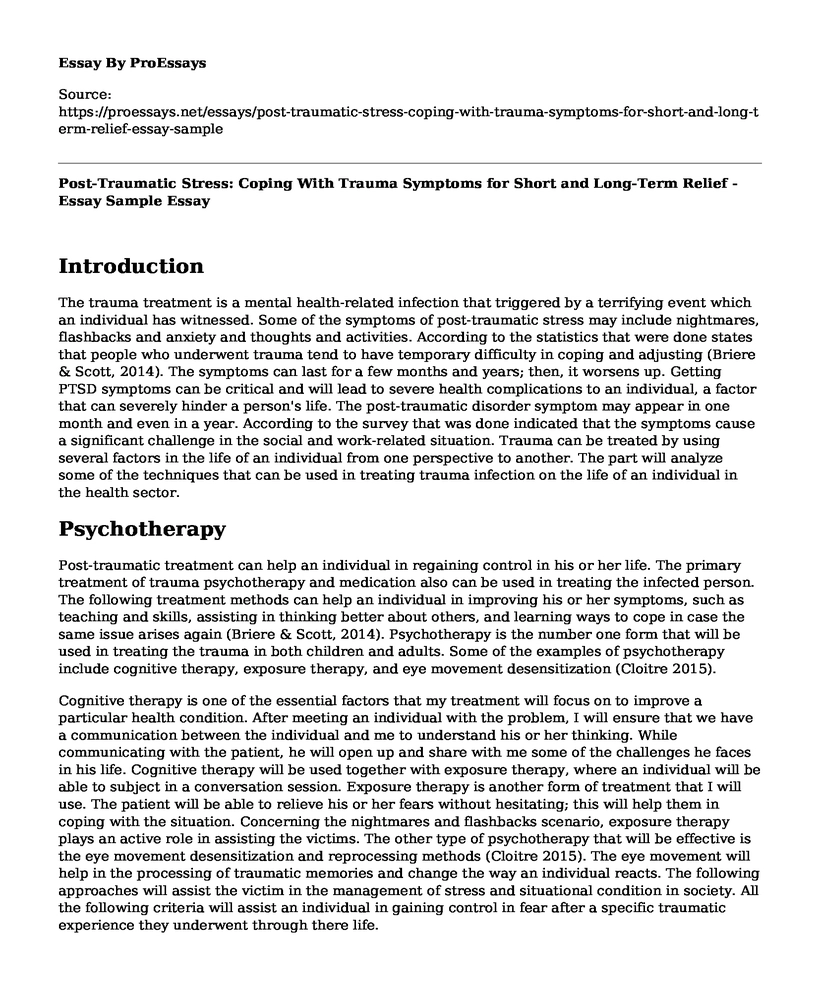Introduction
The trauma treatment is a mental health-related infection that triggered by a terrifying event which an individual has witnessed. Some of the symptoms of post-traumatic stress may include nightmares, flashbacks and anxiety and thoughts and activities. According to the statistics that were done states that people who underwent trauma tend to have temporary difficulty in coping and adjusting (Briere & Scott, 2014). The symptoms can last for a few months and years; then, it worsens up. Getting PTSD symptoms can be critical and will lead to severe health complications to an individual, a factor that can severely hinder a person's life. The post-traumatic disorder symptom may appear in one month and even in a year. According to the survey that was done indicated that the symptoms cause a significant challenge in the social and work-related situation. Trauma can be treated by using several factors in the life of an individual from one perspective to another. The part will analyze some of the techniques that can be used in treating trauma infection on the life of an individual in the health sector.
Psychotherapy
Post-traumatic treatment can help an individual in regaining control in his or her life. The primary treatment of trauma psychotherapy and medication also can be used in treating the infected person. The following treatment methods can help an individual in improving his or her symptoms, such as teaching and skills, assisting in thinking better about others, and learning ways to cope in case the same issue arises again (Briere & Scott, 2014). Psychotherapy is the number one form that will be used in treating the trauma in both children and adults. Some of the examples of psychotherapy include cognitive therapy, exposure therapy, and eye movement desensitization (Cloitre 2015).
Cognitive therapy is one of the essential factors that my treatment will focus on to improve a particular health condition. After meeting an individual with the problem, I will ensure that we have a communication between the individual and me to understand his or her thinking. While communicating with the patient, he will open up and share with me some of the challenges he faces in his life. Cognitive therapy will be used together with exposure therapy, where an individual will be able to subject in a conversation session. Exposure therapy is another form of treatment that I will use. The patient will be able to relieve his or her fears without hesitating; this will help them in coping with the situation. Concerning the nightmares and flashbacks scenario, exposure therapy plays an active role in assisting the victims. The other type of psychotherapy that will be effective is the eye movement desensitization and reprocessing methods (Cloitre 2015). The eye movement will help in the processing of traumatic memories and change the way an individual reacts. The following approaches will assist the victim in the management of stress and situational condition in society. All the following criteria will assist an individual in gaining control in fear after a specific traumatic experience they underwent through there life.
Medication
When the symptoms persist, the patient also can be subjected to the recommended post-trauma medications. Some of the examples of drugs that will be effectively used during this moment include antidepressants, Prazosin, and anti-anxiety medications (Lord et al., 2014). The following remedies will help in controlling the depression and anxiety effect on a patient and create a well sleeping and concentration mechanism for a patient. The drugs such as Prazosin lower the nightmares of an individual, a factor that will tend to improve the mental capabilities of the traumatic person. When the symptoms of the individual traumatic increases, it is therefore advisable for an individual to seek for the services of the doctor.
References
Briere, J. N., & Scott, C. (2014). Principles of trauma therapy: A guide to symptoms, evaluation, and treatment (DSM-5 update). Sage Publications. Retrieved from https://books.google.com/books?hl=en&lr=&id=VtjsAwAAQBAJ&oi=fnd&pg=PP1&dq=Trauma+Treatment&ots=nPtsBeHNnD&sig=K-xkvRP9eA2RpLY-V7qCUcK3BzA
Cloitre, M. (2015). The "one size fits all" approach to trauma treatment: should we be satisfied?. European journal of psychotraumatology, 6(1), 27344.Retrieved from https://www.tandfonline.com/doi/abs/10.3402/ejpt.v6.27344
Lord, J. M., Midwinter, M. J., Chen, Y. F., Belli, A., Brohi, K., Kovacs, E. J., ... & Lilford, R. J. (2014). The systemic immune response to trauma: an overview of pathophysiology and treatment. The Lancet, 384(9952), 1455-1465.Retrieved from https://www.sciencedirect.com/science/article/pii/S0140673614606875
Cite this page
Post-Traumatic Stress: Coping With Trauma Symptoms for Short and Long-Term Relief - Essay Sample. (2023, May 06). Retrieved from https://proessays.net/essays/post-traumatic-stress-coping-with-trauma-symptoms-for-short-and-long-term-relief-essay-sample
If you are the original author of this essay and no longer wish to have it published on the ProEssays website, please click below to request its removal:
- Therapeutic Recreation in Nursing Homes - A Public Health Essay
- Skills for Workplace Success Paper Example
- Recovery in Mental Health - Essay Sample
- Essay Example on Emotional Intelligence: Debates & Models
- Essay on the Long-Term Impact of Sri Lanka's Disaster: PTSD and Its Effect on Survivors
- Essay Example on Processes of Life: Independence, Marriage, Parenthood, Seniority
- Paper Example on Cultural Influences on Cognition: A Cross-Cultural Perspective







